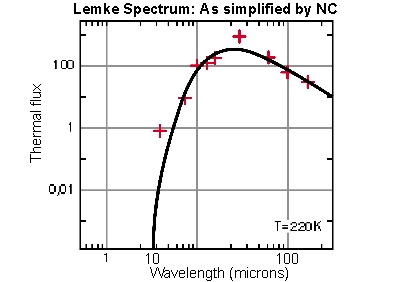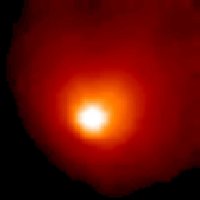INFO 08-1997: ISO's analysis of Comet Hale-Bopp
14 March 1997
If you had infrared eyes, Comet Hale-Bopp would look quite different from the streaky visible object now examined by astronomers' telescopes and amateurs' binoculars all around the world, as the comet approaches its close encounter with the Sun. You would see not just the very fine dust thrown out by the comet, which makes its head and tail conspicuous to ordinary human eyes, but larger particles of dust. The colour or dominant wavelength of the infrared glow would tell you the temperature of the dust cloud. And infrared hues at other wavelengths would reveal the nature of the dust, and let you see what vapours emanate from the comet's nucleus as the Sun's rays warm its chilly surface.The European Space Agency's Infrared Space Observatory ISO inspected Comet Hall-Bopp during the spring and autumn of 1996. The need to keep ISO's telescope extremely cold restricts the spacecraft's pointing in relation to the Sun and the Earth and it ruled out observations at other times. The analyses of the 1996 observations are not yet complete, but already they give new insight into the nature of comets.
Comet Hale-Bopp is believed to be a large comet with a nucleus up to 40 kilometres wide. It was discovered in July 1995 by two American astronomers working independently, Alan Hale and Thomas Bopp. At that time, the comet was a billion kilometres away from the Sun, but 200 times brighter than Halley's Comet was, when at a comparable distance. Comet Hale-Bopp will make its closest approach to the Earth on 22 March, and its closest approach to the Sun (perihelion) on 1 April 1997.
Some scientific results from ISO
The discovery of Comet Hale-Bopp occurred before ISO's launch in November 1995. When first observed by ISO in March and April 1996, the comet was still 700 million kilometres from the Sun, and almost as far from the Earth and ISO. With its privileged view of infrared wavebands inaccessible from the Earth's surface, ISO's photometer ISOPHOT discovered that carbon dioxide was an important constituent of the comet's emissions of vapour.
 |
|
Spectrum covering a huge range of infrared wavelengths from ISO's photometer ISOPHOT. Here the instrument operates as a thermometer, taking the temperature of the comet’s dust cloud. The crosses are the measurements by ISOPHOT and the continous line is the emission expected from an object with a temperature of 220 Kelvin, or about minus 50 °C. By this period of observation in October 1996, the dust cloud was much warmer than in March 1996, when the same instrument obtained a temperature of minus 120 °C. |
Intensive observations of Comet Hale-Bopp were also made by ISO's Short-Wave Spectrometer SWS, the Long-Wave Spectrometer LWS, and the ISOPHOT spectrometer PHOT-S. Results are due for publication at the end of March. They will give details about the composition of the comet's dust and vapour, and also rates of escape of vapour, which will help in assessing the loss of material from Comet Hale-Bopp during this visit to the Sun's vicinity.
"Watch out for some fascinating news," says Thijs de Graauw of Groningen University, who is in charge of the SWS instrument used in this study. "What excites me is the opportunity we shall have to compare dusty Comet Hale-Bopp, seen in the Solar System, with dusty objects far away among the stars which seem to be made of similar materials. Infrared astronomy has a special ability to unify cosmic chemistry at all scales from little dust grains in the Earth's vicinity to vast and distant galaxies."
The dust itself interests the infrared astronomers, not least because their view of the Universe at large is spoiled to some extent by dust left behind by comets. Together with fine debris from asteroids, the comet dust makes a bright infrared band around the sky, which corresponds with the zodiacal light sometimes seen by eye, slanting above the horizon at twilight. ISO's predecessor, the US-Dutch-UK infrared astronomical satellite IRAS, found trails of comet dust much longer and more persistent than the familiar comet tails. ISO has seen a trail from Comet Kopff. By detecting dust grains that are typically much larger than those seen by visible light, ISO scientists hope to learn more about the dust's long-term behaviour in the Solar System.
 |
|
ISOCAM infrared image at 15 μm |
A Commanding Role in Comet Research
As comets are relics from the construction of the Solar System, and played a major role in the formation of the planets, they are a link between the Earth and the wider Universe of stars. The carbon compounds contained in comets probably contributed raw materials for the origin of life on the Earth, and according to one theory the Earth's oceans were made from comet ice. Growing knowledge of the composition and behaviour of comets is therefore crucial for a fuller understanding of our cosmic origins.
ESA has a commanding role in space research on comets. Its Giotto spacecraft was the most daring of the international fleet of spacecraft that visited Halley's Comet in March 1986. Giotto obtained exceptional pictures and other data as it passed within 600 kilometres of the nucleus. Dust from the comet badly damaged the spacecraft, but in a navigational tour de force Giotto made an even closer approach to Comet Grigg-Skjellerup in July 1992. Now ESA is planning the Rosetta mission that will rendezvous with Comet Wirtanen and fly in company with it, making observations far more detailed than the fast flybys of Halley's Comet and Comet Grigg-Skjellerup could achieve.
As for space astronomy, the International Ultraviolet Explorer, in which ESA was a partner, made unrivalled observations of Halley's Comet by ultraviolet light. ESA is also a partner in the Hubble Space Telescope, which saw the historic impacts of Comet Shoemaker-Levy 9 on Jupiter in July 1994, and has recently observed Comet Hyakutake as well as Hale-Bopp. The SOHO spacecraft, built by ESA for a joint ESA-NASA project to examine the Sun, has a distinctive view of comets. It has observed the hydrogen coronas of comets with its SWAN instrument. SOHO's coronagraph LASCO observed Comet Hyakutake rounding the Sun (when it was invisible to ground-based observers) and has discovered seven new comets very close to the Sun.
Only ISO provides astronomers with information from comets across a very wide range of infrared wavelengths unobservable from the ground. Besides Comet Hale-Bopp, ISO has examined Comets Schwassmann-Wachmann 1, Chiron, Kopff, IRAS 1 and Wirtanen. The last of these, Comet Wirtanen, is the target of the Rosetta mission and is now making one of its six-yearly visits to the Sun's vicinity.
Dietrich Lemke of Heidelberg, Germany, who is in charge of the ISOPHOT instrument in ISO, summarizes ISO's unique contribution: "By measuring the extremely weak heat rays from these frosty objects at different distances we have a thermometer to gauge a comet's growing fever when it nears the Sun. As the temperature rises, first one kind of ice evaporates, and then another, producing various chemical signatures in the infrared spectrum. We can also characterize the mineral dust coming out of the comet. So ISO offers a vivid impression of comets in action which no other instrument can match."

